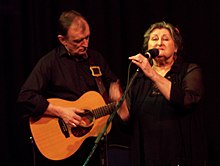Martin Carthy | |
|---|---|
 | |
| Background information | |
| Birth name | Martin Dominic Forbes Carthy |
| Born | 21 May 1941 Hatfield, Hertfordshire, England |
| Origin | London, England |
| Genres | |
| Occupation(s) |
|
| Instrument(s) | |
| Years active | 1960–present |
| Labels | |
| Spouse | |
| Children | Eliza Carthy |
| Relatives |
|
Martin Dominic Forbes Carthy MBE (born 21 May 1941) is an English folk singer and guitarist who has remained one of the most influential figures in British traditional music, inspiring contemporaries such as Bob Dylan and Paul Simon,[1] and later artists such as Richard Thompson, since he emerged as a young musician in the early days of the folk revival in the UK during the 1960s and 1970s.
He was born in Hatfield, Hertfordshire, England,[2] and grew up in Hampstead, North West London. His mother was an active socialist and his father, from a family of Thames lightermen, went to grammar school and became a trade unionist and a councillor for Stepney at the age of 21. Martin's father had played fiddle and guitar as a young man but Martin was unaware of this connection to his folk music heritage until much later in life. His vocal and musical training began when he became a chorister[3] at the Queen's Chapel of The Savoy. He picked up his father's old guitar for the first time after hearing "Rock Island Line" by Lonnie Donegan. He has cited his first major folk music influences as Big Bill Broonzy and the syncopated guitar style of Elizabeth Cotten. Carthy performed his first professional engagement at the age of 16 at The Loft, a coffee bar in Primrose Gardens.[4] Although his father wanted him to go to university to study classics, Carthy left school at 17 and worked behind the scenes as a prompter at the open-air theatre in Regent's Park, then as an assistant stage manager (ASM) on a tour of The Merry Widow, and then at Theatre in the Round in Scarborough.[5] He became a resident at The Troubadour folk club in Earls Court in the early 1960s after his friend Robin Hall persuaded him to visit and listen to the piper Seamus Ennis.[3] He joined Redd Sullivan's Thameside Four in 1961 as a skiffle guitarist and singer.[6][7]
In the early 1960s, Carthy visited Ewan MacColl's Ballads & Blues club to watch a friend, the singer Roy Guest. The main performer that night was Sam Larner. Carthy has since described how Larner's performance of "Lofty Tall Ship" altered his perception of how a traditional folk song could be sung, and how it was a key moment in his own development as an artist.[3]
When American singer Bob Dylan arrived in London for the first time in 1962 to perform in Madhouse on Castle Street, he visited Martin Carthy at The Troubadour, The King & Queen, and The Singers Club.[3] He learned the traditional song "Scarborough Fair" from Carthy, which he later developed into his own song "Girl from the North Country".
Carthy is a mostly solo performer of traditional songs in a very distinctive style, accompanying himself on his Martin 000-18 acoustic guitar; his style is marked by the use of alternative tunings (notably CGCDGA), and a strongly percussive picking style that emphasises the melody.
In 1964, Carthy joined Marian Mackenzie, Ralph Trainer and Leon Rosselson in the group The Three City Four. The group concentrated on contemporary songs, including some of Rosselson's own, and made two albums – the first for Decca and a second, Smoke and Dust (Where the Heart Should Have Been), for CBS. The 1965 eponymous debut The Three City Four featured Carthy singing lead vocals on two tracks – Sydney Carter's "Telephone Song" and Rosselson's own "History Lesson".[8] Roy Bailey would replace Carthy when he later left the group.
Carthy's debut solo album, Martin Carthy, was released in 1965, and also featured Dave Swarbrick playing fiddle on some tracks, although he was not mentioned in the album's sleeve notes. Carthy's arrangement of the traditional ballad "Scarborough Fair" was adapted, without acknowledgement, by Paul Simon on the Simon and Garfunkel album recording Parsley, Sage, Rosemary and Thyme in 1966. This caused a rift between the pair which was not resolved until Simon invited Carthy to sing the song with him on-stage at the Hammersmith Apollo in 2000.[4][9]

He has also been involved with many musical collaborations. He has sung with The Watersons since 1972; was twice a member of British folk rock group Steeleye Span; was a member of the Albion Country Band 1973 line-up, with members from the Fairport Convention family and John Kirkpatrick, that recorded the Battle of the Field album; and was part of the innovative Brass Monkey ensemble, which mixed a range of brass instruments with Carthy's guitar and mandolin and John Kirkpatrick's accordion, melodeon and concertina. Carthy was also a member of The Imagined Village for all three of their albums (2007–2012).
For many years Carthy enjoyed a creative partnership with fiddle player Dave Swarbrick; more recently, Waterson:Carthy has provided the forum for his successful musical partnership with wife Norma Waterson and their daughter Eliza Carthy.
In June 1998 he was appointed an MBE in the Queen's Birthday Honours. He was named Folk Singer of the Year at the BBC Radio 2 Folk Awards in 2002, and again in 2005 when he also won the award for Best Traditional Track for "The Famous Flower of Serving-Men". In the 2007 Folk Awards Martin Carthy and Dave Swarbrick won Best Duo. In 2008 he was made an Honorary Fellow of the University of Central Lancashire. In 2014 he was awarded the Lifetime Achievement Award at the BBC Radio 2 Folk Awards.
